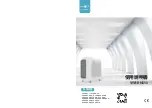
9
4. Ensure the color of the wires of the outdoor unit and the
terminal numbers are the same as the indoor unit’s. Fig-
ure 22B.
L N S
L1 L2 S
or
Figure 22B
5. Wrap the wires not connected with terminals with insula-
tion tape, so they will not touch any electrical compo-
nents. Secure the wires onto the control board with the
cord clamp.
Connect the Cable to the Outdoor Unit
1. Remove the electrical control board cover from the out-
door unit by loosening the screw as shown in Figure 23A.
G
Cover control
Over 1
3/5in.(
40mm
)
Terminal block
Conduit panel
Connecting
cable
Power supply
cord
Outdoor unit
Figure 23A
Power supply
cord
Power supply
1 208-230V~60Hz
Special branch circuit breaker
(Fuse/Breaker capacity: 20A)
NOTE:
Cord clamp must be of correct size to prevent loosening
or cords slipping from the clamp. Select proper cord diameter
to fill the holes on the cord clamp.
Figure 23B
2. Remove caps on the conduit panel.
3. Temporarily mount the conduit tubes (not included) on
the conduit panel.
4. Connect the power supply and low voltage lines to the
corresponding terminals on the terminal block. (See
Models A and B.)
To indoor unit
To power supply
L1 L2 S L1 L2
(A)
To indoor unit
To power supply
L1 L2 S L1 L2
(B)
5. Ground the unit in accordance with local codes.
6. Be sure to size each wire and allow several inches more
than the required length for wiring the unit.
7. Using lock nuts, secure the conduit tubes.
Comply with all local codes when running electrical wire from the
indoor to the outdoor unit. All wires should be firmly connected
and no wires should touch the refrigerant tubing, compressor or
any moving parts. Loose wiring may cause the terminal to
overheat, result in the unit’s malfunction or create a fire hazard.
A means of disconnecting the unit must be provided and located
where it is easily accessible.










































